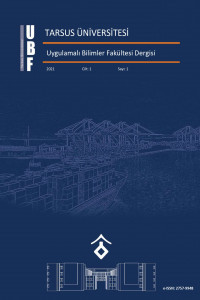TOPSIS Modeli ile Dünya Sıralamasında En İyi Üniversitelerin Veri Analizi
Bu çalışmada dünya üniversiteleri arasındaki sıralama sistemlerinin verilerinin analiz edilmesi ve TOPSIS yöntemi ile sıralanması amaçlanmıştır. Bu çalışma, dünya üniversitelerinin sıralama sistemlerinin özellik ve kriterlerinin bir analizidir. Üniversiteleri sıralamak için onlarca farklı sistem olduğundan, bu çalışma daha popüler sistemlere odaklanmaktadır. Bu sistemlerin her birinin farklı kriterleri ve sistematiği olduğu düşünüldüğünde, çalışma karşılaştırma amaçlı değildir. Türkiye'de son yıllarda hızla artan üniversitelerin dünya ile uyumlu hale gelebilmesi için bu kriterleri dikkate almak ve yapılanmalarını bu kriterlerden bazılarına göre oluşturmak mümkündür. Türkiye'deki üniversitelerin daha üst sıralarda yer alabilmesi için Avrupa ve Amerika üniversitelerinin ardından Yakın ve Uzak Doğu'daki üniversitelerin bilimsel çalışma, fiziki ve sosyal imkanlar ve öğretim üyesi sayısı gibi özelliklerinin incelenmesi faydalı olacaktır. Böylece her üniversite misyon ve vizyonunu uluslararası gelişmelere göre düzenleyebilir.
Anahtar Kelimeler:
: Çok Kriterli Karar Verme, Karar Destek Sistemleri, TOPSIS, Dünya Üniversiteleri, Sıralama Kriterleri.
DATA ANALYSIS of the TOP UNIVERSITIES in the RANKING via the TOPSIS MODEL
In this study, it is aimed to analyze the data of the ranking systems among the world universities and to rank them with the TOPSIS method. This study is an analysis of features and criteria of the ranking systems of world universities. Since there are dozens of different systems for ranking universities, this study focuses on the more popular systems. Considering that each of these systems has different criteria and systematics, the study is not for comparison purposes. It is possible to consider these criteria and to establish their structuring according to some of these criteria in order for the universities in Turkey, which have increased rapidly in recent years, to become compatible with the world. For universities in Turkey to rank higher, it would be beneficial to examine the characteristics of European and American universities, and then universities in the Near and Far East, such as scientific study, physical and social facilities, and the number of faculty members. Thus, each university can organize its mission and vision according to international developments.
Keywords:
Multi-Criteria Decision Making, Decision Support System, TOPSIS, World University, Ranking Criteria.,
___
- Angelis D.I. and Lee, C.Y., (1996). Strategic investment analysis using activity based costing concepts and analytical hierarchy process techniques”, International Journal of Production Research, 34 (5) (1996), pp. 1331-1345.
- Atici, K. B., Yasayacak, G., Yildiz, Y., & Ulucan, A. (2021). Green University and academic performance: An empirical study on UI GreenMetric and World University Rankings. Journal of Cleaner Production, 291, 125289.
- Catellani, L., Colosimo, B. M., & Semeraro, Q. (2005). Analysis and comparison of university ranking models. 8th “Toulon-Verona” Quality in Services conference, September 8-9, Palermo, İtaly.
- Huang, T.C.K., Chen Y.L. and Chang, T.H. (2015). A novel summarization technique for the support of resolving multi-criteria decision making problems, Decision Support Systems, 79 (2015), pp. 109-124.
- Hwang, C.L., Yoon, K. (1981). Multiple attribute decision making methods and applications, Springer, Berlin Heidelberg.
- İsmail, E. M. (2010). Ranking of universities. 2nd International Conference on Assessing Quality in Higher Education, 6-8 December, Lahora, Pakistan.
- Perchinunno, P., & Cazzolle, M. (2020). A clustering approach for classifying universities in a world sustainability ranking. Environmental Impact Assessment Review, 85, 106471.
- Pouris, A., & Pouris, A. (2010). Competing in a globalising world: International ranking of South African universities. Procedia-Social and Behavioral Sciences, 2(2), 515-520.
- The Times Higher Education-QS World University Rankings. (2022). World university rankings 2022. Access Date: 10 June 2022, https://www.topuniversities.com/university-rankings/world-university-rankings/2022.
- Yang, J. L. & Tzeng, G. H. (2011). An integrated MCDM technique combined with DEMATEL for a novel cluster-weighted with ANP method”, Expert Systems with Applications, no. 38(3), pp. 1417-1424.
- Yavuz, S. A. K. A., & Yaman, S. (2011). Üniversite sıralama sistemleri; kriterler ve yapılan eleştiriler. Yükseköğretim ve Bilim Dergisi, (2), 72-79.
- Zhang, K. & Dai, J. (2022). A novel TOPSIS method with decision-theoretic rough fuzzy sets, Information Sciences, no. 608, pp. 1221-1244.
- Yayın Aralığı: Yılda 2 Sayı
- Başlangıç: 2021
- Yayıncı: Tarsus Üniversitesi
Sayıdaki Diğer Makaleler
Kovid Sonrası Dönemde Yorgunluk ve Yorgunlukla Başa Çıkma Stratejileri: Bir Pilot Çalışma
Ayşenur GÖKŞEN, Hikmet KOCAMAN
TOPSIS Modeli ile Dünya Sıralamasında En İyi Üniversitelerin Veri Analizi
Kevser ŞAHİNBAŞ, Abdurrahman KESKİN
Avrupa Birliği Bankacılığında Denetimsel ve Hukuksal Dönüşüm
Şenol KANDEMİR, Özge DEMİRDELEN
TÜRK VERGİ HUKUKUNDA PEÇELEME VE SOSYAL PSİKOLOJİ
DENİZYOLU TAŞIMA İŞLETMELERİ TARAFINDAN KARŞILANAN YURTDIŞI GİDERLERİNİN MUHASEBELEŞTİRİLMESİ
